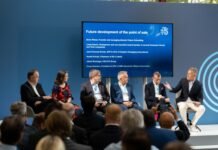While Heidelberg took on considerable debt to reduce its payroll and absorb operational losses and investments in its digital press development it is now self-correcting several of its major attempts at changing course. One of the developments that can be said to have worked out well is its investment in China which started under the regime of Bernhard Schreier. The Heidelberg Shanghai factory is perhaps one of its most viable manufacturing plants and situated close to its still lively Asian market. The new CS 92 press (92 cm or 37-inches) which is exclusively built in Shanghai has also gained traction. For Heidelberg to survive, one assumes that it will have to continue to move higher technology, automation and production to this plant.
The other Schreier initiative, that of jointly building the Nexpress digital press with Kodak was discontinued long ago with Heidelberg divesting its 50% interest in the project and absorbing significant losses. Schreier’s initiative for establishing the global Print Media Academy with an iconic landmark building in the centre of the city has also ended with a whimper. Schreier’s bold initiative in extending the company’s sheetfed offset presses to very large format presses has now been discontinued as per the announcement of 17 March 2020.
Schreier and Heidelberg created a large building in Wiesloch which he claimed as necessary for the assembly of the large format presses. When I, as a humble brown journalist, questioned him about it in Mumbai, he was not amused. The question actually had a real context (apart from my interest in architecture) since I expected him to talk about the innovative nature of the construction. (At the time, I had been very impressed by several outstanding features of Komori’s newly built factory in Tskuba City near Tokyo.)
Gerold Linzbach
After Schreier came Gerold Linzbach and the present leadership of Rainer Hundsdorfer. Under Linzbach came the full acquisition of Gallus and Ferdinand Ruesch becoming the anchor shareholder of Heidelberg in exchange for his stake. The other major initiative apart from trying to restructure the company’s debt and slimming down its personnel was that of collaborating with Fujifilm Dimatix to build a B1 sheetfed digital press in record time.
Given that one is an outsider 8,000 miles away with little access to day to day developments I still think this attempt to take on Landa is creditable and would like to understand where it has gone wrong and why this development has to be discontinued as per the press release revealing the company’s latest ‘Action Plan.’ Having seen the live output being produced on a press at the company’s beta customer Multicolor I now have to wonder if this was some kind of optical illusion or magic trick.
Of course the machine had to be made reliable and faster, but already at the time of the beta site customer demonstration there were hints that the progress to series production would be slow. Still, there were many things right with this technology approach and the press print quality to my limited understanding at least was on track leaving the questions of reliability, cost and speed to be answered.
Hundsdorfer and the current era
In the current era of Hundsdorfer the major initiatives have been to try and strengthen the company’s equity by bringing in Masterworks as a stakeholder. This makes eminent sense since the company needs to stronger in carton converting to take advantage of the still growing packaging sector and all its earlier attempts in this direction failed. The second initiative of the current regime was to build the company’s annuity incomes such as spare parts, services, consumables and a novel attempt at press subscription or leasing.
Leasing or subscription contract for a press is a challenging and difficult initiative borrowed from the digital press industry. First of all the depreciation of digital presses is very rapid – 3 to 7 years versus the working life of an offset press which is close to 40 years. Secondly the banking and financial laws that would either make the subscription model attractive or abhorrent vary greatly from country to country.
Ironically, it is printing and the need for education and communication that are a common thread of equalization between diverse cultures. And, in spite of the globalization of capital, it is the access to finance capital, arbitrage of currencies and trade barriers that are the walls that protect inequality between citizens and countries. In any case, it seems that Heidelberg’s subscription experiment of placing presses at customer sites is also being discontinued.











